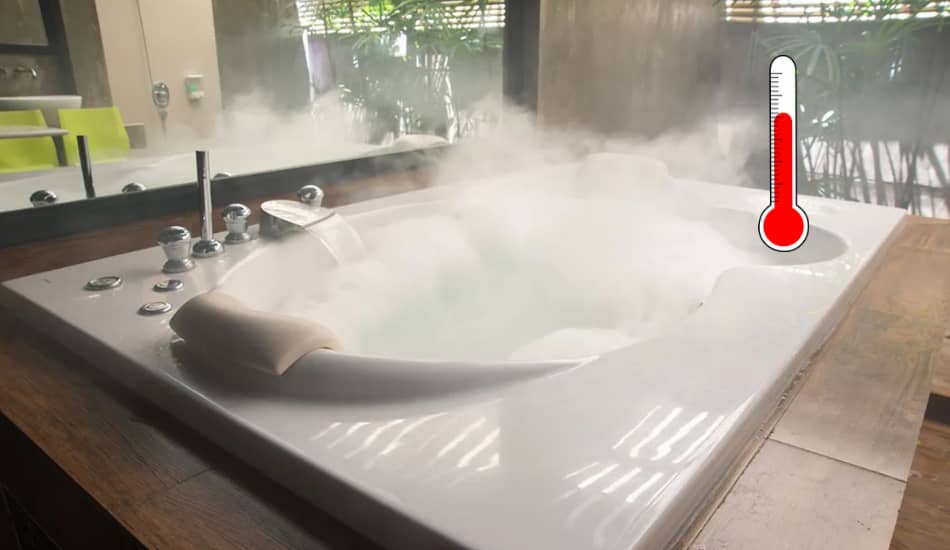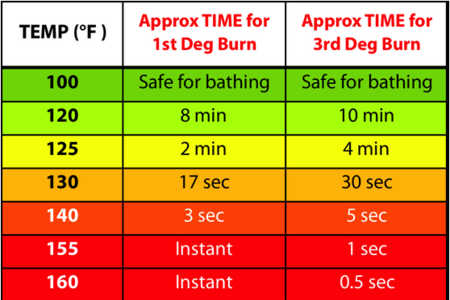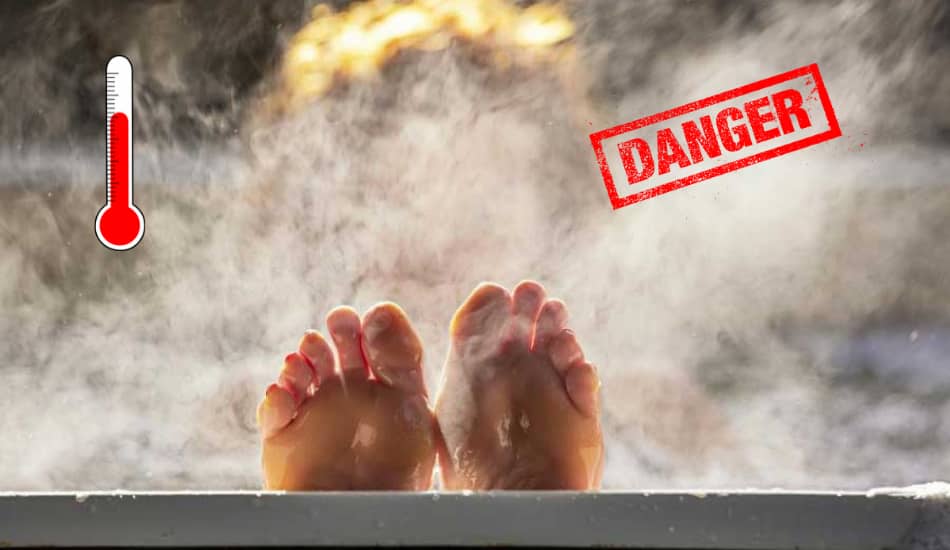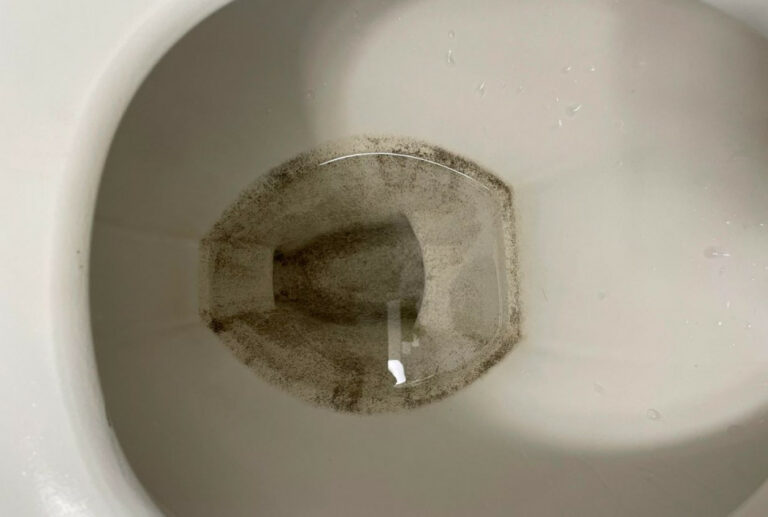What Is A Safe Bath Water Temperature? Dermatologist Explain

Taking a bath or shower is something that we do almost every day. But have you ever wondered what is the hottest water temperature that is safe for your skin? Usually, people do not think about what water temperature is considered optimal for a bath or shower. They just pick it up according to their own feelings, not knowing the consequences that hot water can leave on the skin. So let’s see what is the safest water temperature for taking a bath.
Table of Contents
What is a Safe Bath Water Temperature?
So What Is a Safe Bath Water Temperature? Ideally, dermatologists and experts say that the most ideal and safest water temperature for bathing and showering is one or two degrees above the body temperature that is 98.6 degrees Fahrenheit (37 °C). So, during a bath, the best temperature range is between 98.6 to 100 degrees (36.6 to 37 °C).
Certain studies were carried out on to the question of what is the ideal temperature for taking a bath, and the optimal value is considered to be a range of 98.6 °F (37 °C), close to the standard temperature of a healthy body. Water with a temperature of 98.6 °F to 104 °F (37 °C to 40 °C) is considered warm, while the above 104 °F (40 °C) is already hot.
You will meet a lot of people who advocate the benefits of having a bath in very hot or very cold water. When it comes to the optimal water temperature that is used for showering or bath, that can also wash away any dirt and bacteria from the body don’t need to be higher than 112 °F (44.4 °C), says dermatologist Melissa Piliang from Cleveland Clinic.
| Water Temperature: | Normal Water Temp. | Max. Safe Water Temp. |
|---|---|---|
| Bath | 98.6 to 100 °F (37 to 37.7 °C) | 120 °F (48.8 °C) |
| Shower | 98.6 to 100 °F (37 to 37.7 °C) | 120 °F (48.8 °C) |
While many people today advocate different showering and bathing methods that you will find on Google and YouTube, the best is to stick to the advice of experts. If you want to know how long it takes for an average bathtub to fill, read the article in which I wrote How Long Does it Take to Fill an Average Bathtub?
What is the Maximum Safe Water Temperature For a Bath?
The maximum temperature for bathing that the Department of Health recommends should be no higher than 120 °F (48.8 oC), while for showering should not exceed 109 °F (43 oC). When it comes to babies, the maximum temperature should not be higher than 98.6 °F (37 oC). Keep in mind that when you are taking a bath, always make sure to put the cold water first and then bring up the hot water to the required temperature.

What is the Hottest Safe Water Temperature For a Shower?
The longer you are exposed to hot water, the higher the risk of scald injury. The time that you can spend at the maximum water temperature in a hot shower is around five minutes. But there is also another question: what is the safest maximum temperature at which you can be in the shower?
According to dermatologists, the hottest safe water temperature for a shower should not go higher than 109 °F (43 oC). Of course, when it comes to small children who are much more sensitive to heat, they must use lower temperatures below 100 °F.
What Is The Maximum Temperature That Can Run?

The maximum temperature that water from the tap can run is 140 °F (60 °C). Most experts and doctors are suggesting to adjust on your water heater the max temperature in your home to 120 °F (48.8 °C) to prevent injury. On the other hand, the temperature that is needed to wash hands, bacteria, or any environmental dirt is 112 (44.4 °C) degrees or lower. During a shower or a bath, the water temperature should feel warm and not uncomfortably hot.
When it comes to the younger generation, the skin can replace the lipid layer much faster compared to older people. As people age, there is less and less tolerance for hot water, and that leads to dry, red skin, itchy and sometimes even eczema say, according to dermatologists.
Then even a moisturizer can’t replenish the body’s natural oils. For comparison, if a young 20-year-old man is taking two hot showers a day and he is fine, at the age of 40 he may find that he has dry patches on his skin if he continues to have hot showers.
Related Article: What Is the Right Temperature For a Hot Tub?
What’s a Good Water Temperature For a Bath?
Ideally, dermatologists said that the most suitable water temperature when it comes to bathing and showering should be only a few (one or two) degrees above the body temperature of 98.6 (37 °C) degrees Fahrenheit. So the idle water temperature would be between 98.6 °F to 100 °F (37 °C to 37.7 °C). Keep in mind that for the elderly people can be dangerous to bath in extremely cold or extremely hot water.
Therefore, a water temperature that exceeds 120 °F (48.8 °C) can be really dangerous, and you need to pay attention because it can cause heart and cardiovascular problems.
1. How Hot Water Affects Your Body
By using extremely hot water during a bath or shower, can cause excessive flow of blood to the skin which can lead to cardiovascular strain. It may cause the heart to work too hard and the seniors that have heart problems may find themselves in a dangerous situation. We should also not forget the possibility of burns that can occur due to extremely hot water during the bath or shower.
Water temperature that exceeds 120 °F (48.8 °C) is far too hot for anyone (young or old) to have a bath. As we said, hot water can easily cause serious burns on human skin in a short period of time. If you are a senior that can’t move and react fast to turn off the faucet, you can risk burns that in most cases lead to serious infections.
2. How Cold Water Affects Your Body
For those who are using extremely cold water for a bath or shower, it can also lead to side effects related to the body. If cold water is used for more than several minutes, it can cause blood vessels to narrow. Blood flow is reduced and the amount of blood that needs to flow true skin, internal organs, and the heart is reduced. Also, cold water can cause a lowering the body temperature if the water is colder than the temperature of the body.
Tips For Safe Bathing

- Homeowners should adjust their water temperature so that it is never too hot, whether it is for bathing or showering. I advise you to get a bath thermometer so you can always check the water temperature in your bath or shower without guessing.
- Always make sure that the bathroom is heated to a temperature that is comfortable for bathing. If the room temperature and water temperature are similar, the body will easily adjust to it.
- Always check the water temperature before entering the tub or shower. Do this with a finger or toe to see if it is comfortable.
- If you have an elderly person that you need to assist, be patient when they are entering the tub or shower.
How To Wash Face With Hot Water During The Shower?
Washing the face during the shower with relatively hot water at 112 oF (44.4 oC), which is then followed by a small splash of cold water to your face, can help open up the pores so you can then clean them out better. Most dermatologists suggest that the temperature for cold water should be around 70 degrees Fahrenheit (21 C), while in some others the temperature is even lower.
Benefits Of Switching Between Hot And Cold Water
Some dermatologists are not convinced that there are health benefits when you are switching between hot and cold water, while others think differently. The opinions of some dermatologists are that going back and forth between cold water and hot water can increase blood flow to the skin, but there is no scientific evidence for that.
One thing is for sure, for people that have problems with heart disease or high blood pressure, they need to avoid high temperatures of any kind. Professional athletes are sometimes using very cold (below 50 oF) baths or showers to prevent injuries. The study in 2012 confirmed that supercold baths can lead to hypothermia, impaired consciousness, or abnormal heart rate.
Showering Methods By Using Hot Water
Dr. Piliang says that she is using her showering technique where she first turns on the tap with extra hot water to steam up the bathroom, and after she turns it down to a solid temperature of 95 oF to 100 oF (35 to 37.7 oC) before she gets in. By using this method, she avoids the drying and reddening effects on her skin and gets all the benefits of hot steam.
People are convinced that getting a cold shower in the morning that is around 70 oF (21 oC) is the same as getting a cup of coffee and that it will wake them up. That may be true if you are the type of person that is affected by it. Most important thing is that you are not feeling dry and itchy after the shower.
Is 48 Degree Bath Too Hot?
The maximum water temperature due to the international Plumbing Code regulates that for the shower and tub faucets must not exceed 120 degrees Fahrenheit (48.8 oC). Any temperature that is above 102 degrees Fahrenheit (39 oC) can seriously harm a person’s health if they stay in that water for too long.
If you are interested on How Much Does It Cost To Run A Bath, read the following article.
Final Thoughts
Finally, I can suggest that you choose comfortable water according to your feelings, but do not forget that too hot water will negatively affect your heart. At a comfortable temperature of 98.6 oF (37 oC), a person will be fine, and his vessels will not randomly narrow or expand, the blood flow will not change.
Water that is too hot is harmful to the skin. It washes away the hydrolipidic protective layer. And if we get out of the shower steamed, and the immune system is not in order, then there is a risk of getting sick with ARVI or getting an exacerbation of chronic diseases. I hope this article helped you.








